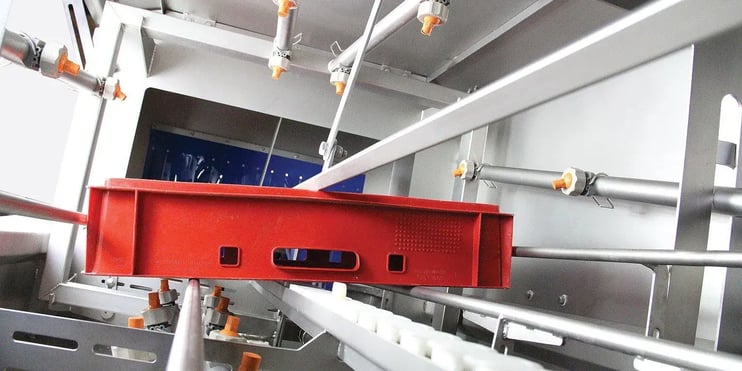When choosing the correct crate washer: be aware of the type and degree of soiling of the crates

Of course the idea is that your crate washer cleans your crates optimally. That is why it is important that you use the correct washing process. Four variables are important here: strength, time, temperature and chemicals. The type and extent of the soiling largely determines what the washing process should be.
The variable forces (also called the mechanical work or movement), time, temperature and chemicals (the cleaning agent) together form the so-called Sinner Circle: a tool that is used as standard in the professional cleaning world.
These four factors all influence each other. For example, a higher time factor means that less chemicals or a lower washing temperature is required.
Types of soiling
The ratio in which the variables of the Sinner Circle should be used depends upon, among other things, the type of soiling on the crates:
-
Pollution 1: Proteins
Proteins must be removed at low temperatures (30 to 40 degrees Celsius). If the temperature is too high, the proteins will coagulate. -
Pollution 2: Blood residues
This soiling can be removed at low temperatures because they contain proteins.
(30 to 40 degrees Celsius) -
Pollution 3: Fats
Are best to removed with a high water temperature (50 to 65 degrees Celsius). -
Pollution 4: Sticker and glue residues
Stickers and glue can be removed using high pressure and with a high temperature. A separate sticker removal module integrated into the crate washer is available for this. -
Pollution 5: Dried-in dirt
Has the crate been in a freezer for a long time or standing in the sun? Then the dirt will have dried up 'To properly clean such crates, sufficient soaking time is required.
An example of a cleaning process would be: when a crate is soiled with proteins and fats, the proteins have to be removed first, at a low temperature. Subsequently the fats can be removed in the second phase, by means of a high temperature wash.
Choice of one or two tanks
You can choose a crate washer with one or two water tanks. In the example above, a two-tank washer would be necessary, because two different water temperatures are used. The two different types of soiling must both be removed by a different washing process.
Also the degree of soiling - low, medium or high - also plays a role in the choice between a one or two-tank crate washer. When there is a high level of soiling and with dried-in dirt, a soaking period is necessary. The washing process is then divided into a pre-wash (tank 1) and a main-wash (tank 2). When there is only one type of soiling, and it is only light then a one-tank washer is often sufficient.What are the points of attention when buying a crate washer?
Do you want quick and easy insight into what to think about when purchasing a crate washer? Then fill in the checklist 'Points to consider when buying a crate washer'. The checklist will provide you with the following:
- A better understanding of the variables involved in selecting a crate washer
- You will avoid making a hasty decision resulting in choosing the wrong crate washer for your business
- You will take the next step in selecting the perfect crate washer for your business.
.webp)





.jpg?width=600&height=300&name=eCIS-(4).jpg)
.jpg?width=600&height=300&name=eCIS-(2).jpg)